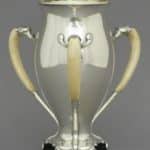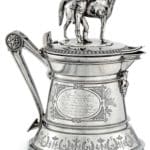And the Winner Is…
by Jessica Kosinski
Human beings have always had a desire to prove something to themselves and to others. That desire to learn, grow, and succeed is what has driven us throughout history.
It is also what led to the idea of rewarding those who are the best in certain fields, especially sports, which eventually gave birth to the idea of presenting prizes in the form of things like medals and trophies for those that win competitions, whether academic, athletic, or otherwise. This month let’s take a peek at the history and value of these coveted items.
The History of Trophies:
The idea of the trophy in a reward sense goes back hundreds of years. One early example is in ancient Greece when amphorae and laurel wreaths were given to those who won sporting events. Eventually, that ancient Greek practice evolved into the distribution of gold, silver, and bronze medals during the modern Olympics, which are also quite collectible.
Many trophies are also shaped like a single cup with no handles at all. They are often called chalice-style trophies. Arguably, the most famous of them is hockey’s Stanley Cup, which was named after Sir Fredrick Arthur Stanley. He donated it to the “championship hockey club of the Dominion of Canada” in 1892. Although, it was later acquired by the National Hockey League (NHL).
The Evolution of Trophy Styles:
We have obviously come a long way in terms of trophy styles from the laurel wreaths of ancient Greece to some of the elaborate trophy styles of the modern era. Over the last 100 years or so trophies in the United States have continuously evolved and often depict elaborate 3D figures perched on top of them. Cars, horses, athletes, and sporting equipment are common subjects for those types of trophies.
Non-Sports Trophies:
One of the most recognizable 3D figural trophies in the United States is actually not a sports trophy at all. It’s the Oscar, which is given to winners at the Academy Awards each year. The Oscar was designed in 1929 by Cedric Gibbons, who was MGM’s art director at the time. Today Oscar awards are highly collectible and fairly rare because most of them were kept by the winners and their families. The same is true of most awards given out on other awards programs devoted to the arts, such as the Emmys and the Grammys.
There are also plenty of other non-sports trophies that are collected by people in the United States. One trophy group that is often ignored is the military trophy group. Most people think that all military awards are medals, but those in the military will tell you that actual trophies for service are also given to certain groups under certain circumstances. Those trophies can be quite interesting to military collectors. In fact, among other trophies, military branches often give out their own sports trophies for those who win military sporting events or endurance challenges.
Trophies and Their Values:
Many trophies are truly priceless, like the Stanley Cup. It is adored by the world, especially hockey fans and sports historians. A price cannot be put on the kind of history that it has. However, a trophy can also be valuable simply because of its manufacturer. For example, a trophy cup made by Tiffany & Co. and presented in 1919 by the New York Yacht Club was recently given an estimated value of around $6,000. While many people wouldn’t care about a yacht club trophy, the name “Tiffany & Co.” has a lot of notoriety.
The material out of which a trophy is made also plays a role in its value. Many of today’s basic trophies are made of inexpensive materials and mass-produced. However, antique trophies, and even some modern trophies made for major events, are made of silver or gold. That makes them valuable for their scrap value alone.
Another thing to consider is the history of a specific trophy, especially when it’s a sports trophy. For example, if a trophy was given to a golfer during that golfer’s final tournament win before he or she retired then it might have extra value to fans of that particular golfer. The same is true for any sports trophy associated with the career of one of that sport’s most memorable or successful players.
Monetary value is one reason to collect trophies, but most people collect trophies relating to a particular type of event, often an event which they themselves or a close family member participated in. There are also people who enjoy collecting trophies depicting certain things, for example race cars or golfers.
Another reason you might consider collecting trophies, albeit less expensive ones, is that they make excellent decorations. If you are planning to turn a room in your home into a “man cave” or gaming area, you can easily put up shelves and line part or all of them with a combination of your family’s own trophies and those you find in antiques shops and at yard sales.
How to Collect Trophies:
One unique thing about trophies is that they are made to commemorate specific events, people, and moments in time. As such, you don’t usually have to worry about dating most trophies. Most of them are clearly marked with not only the date, but a lot of other relevant information. Instead, what you should look for when collecting trophies for monetary value are things like who made the trophy, what it commemorates, and what material it is made out of. As is the case when collecting almost anything else, the value will also depend on the condition of the trophy. So, be sure to check any trophy you are interested in carefully for damage before you purchase it.
One last thing to be aware of is that even replicas of famous trophies can have some monetary value as collectibles. So, just because a trophy is “fake” doesn’t mean that it has no value. As long as it is made well and the seller is not claiming that it is the real thing, it still might not be a bad investment.











Related posts: